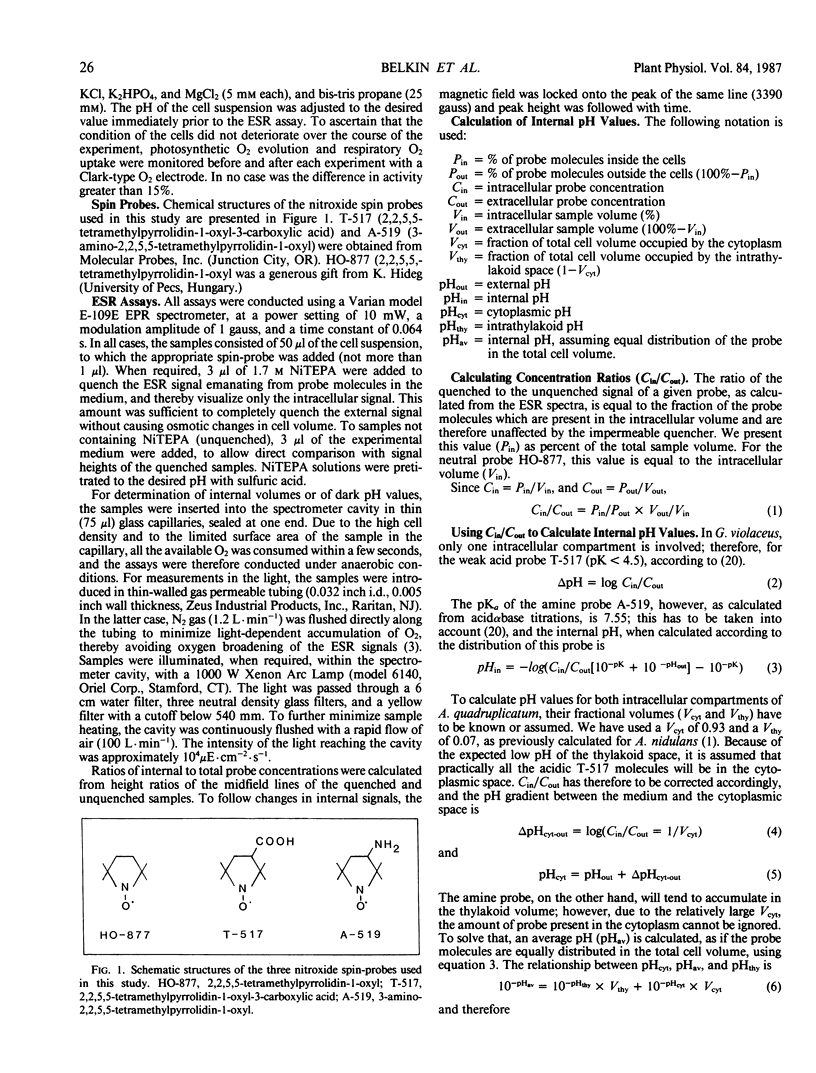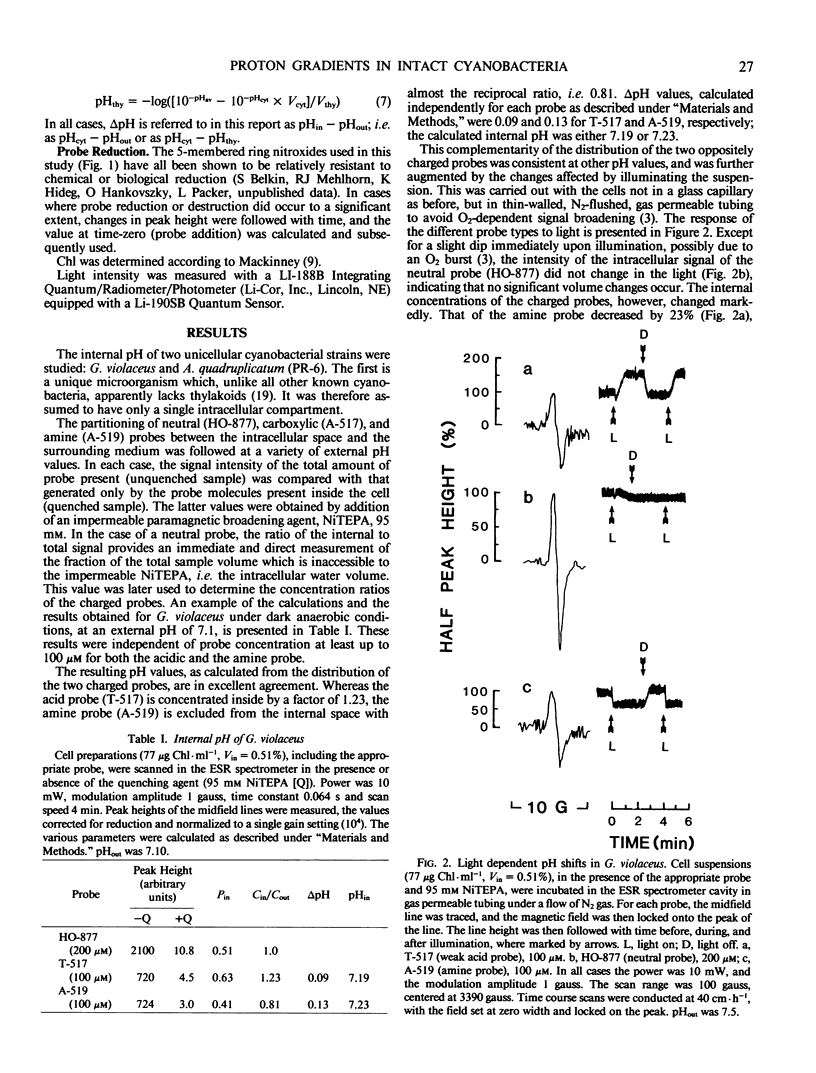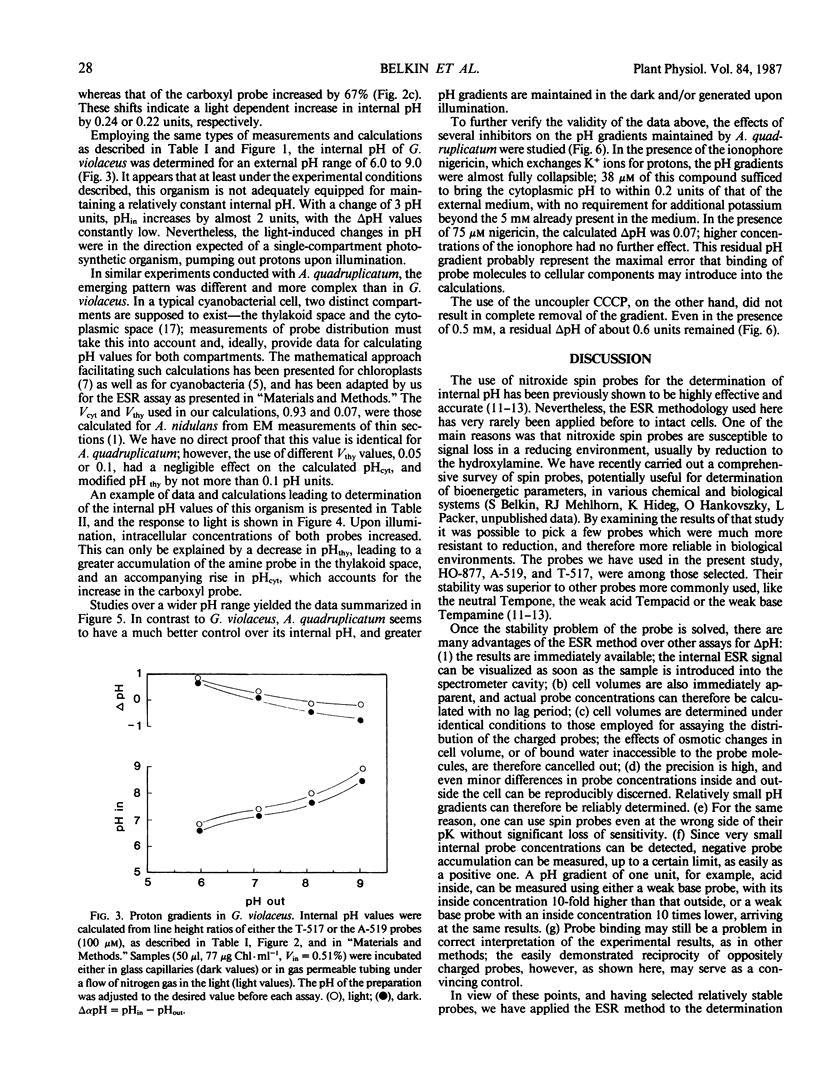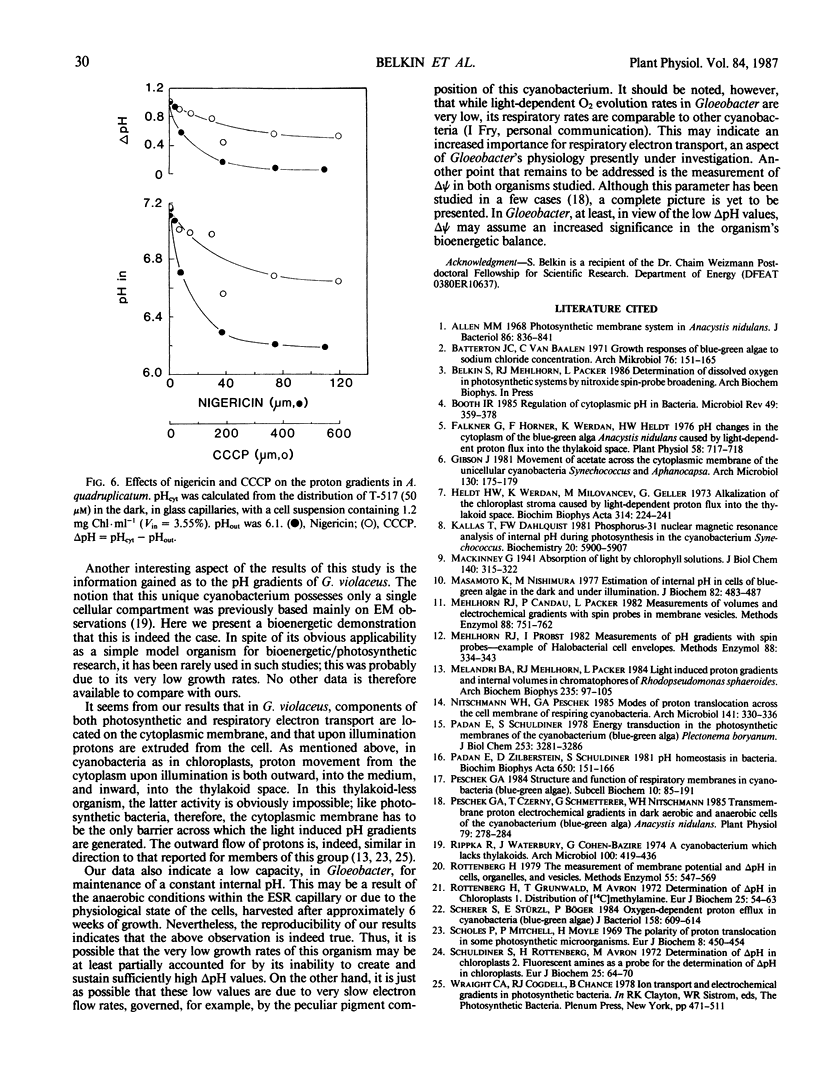Abstract
The internal pH values of two unicellular cyanobacterial strains were determined with electron spin resonance probes, over an external pH range of 6 to 9, in the light and in the dark. The slow growing, thylakoid-lacking Gloeobacter violaceus was found to have a low capacity for maintaining a constant internal pH. The distribution pattern of weak acid and amine nitroxide spin probes across the cell membranes of this organism, in the light and in the dark, was consistent with the assumption that it contains a single intracellular compartment. At an external pH of 7.0, intracellular pH was 6.8 in the dark and 7.2 in the light. The cells of Agmenellum quadruplicatum, a marine species, were found to contain two separate compartments; in the dark, the pH of the cytoplasmic and the intrathylakoid spaces were calculated to be 7.2 and 5.5, respectively. Upon illumination, the former increased and the latter decreased by about 0.5 pH units.
Full text
PDF





Selected References
These references are in PubMed. This may not be the complete list of references from this article.
- Allen M. M. Photosynthetic membrane system in Anacystis nidulans. J Bacteriol. 1968 Sep;96(3):836–841. doi: 10.1128/jb.96.3.836-841.1968. [DOI] [PMC free article] [PubMed] [Google Scholar]
- Batterton J. C., Jr, Van Baalen C. Growth responses of blue-green algae to sodium chloride concentration. Arch Mikrobiol. 1971;76(2):151–165. doi: 10.1007/BF00411789. [DOI] [PubMed] [Google Scholar]
- Booth I. R. Regulation of cytoplasmic pH in bacteria. Microbiol Rev. 1985 Dec;49(4):359–378. doi: 10.1128/mr.49.4.359-378.1985. [DOI] [PMC free article] [PubMed] [Google Scholar]
- Falkner G., Horner F. pH Changes in the Cytoplasm of the Blue-Green Alga Anacystis nidulans Caused by Light-dependent Proton Flux into the Thylakoid Space. Plant Physiol. 1976 Dec;58(6):717–718. doi: 10.1104/pp.58.6.717. [DOI] [PMC free article] [PubMed] [Google Scholar]
- Heldt W. H., Werdan K., Milovancev M., Geller G. Alkalization of the chloroplast stroma caused by light-dependent proton flux into the thylakoid space. Biochim Biophys Acta. 1973 Aug 31;314(2):224–241. doi: 10.1016/0005-2728(73)90137-0. [DOI] [PubMed] [Google Scholar]
- Kallas T., Dahlquist F. W. Phosphorus-31 nuclear magnetic resonance analysis of internal pH during photosynthesis in the cyanobacterium Synechococcus. Biochemistry. 1981 Sep 29;20(20):5900–5907. doi: 10.1021/bi00523a038. [DOI] [PubMed] [Google Scholar]
- Masamoto K., Nishimura M. Estimation of internal pH in cells of blue-green algae in the dark and under illumination. J Biochem. 1977 Aug;82(2):483–487. [PubMed] [Google Scholar]
- Melandri B. A., Mehlhorn R. J., Packer L. Light-induced proton gradients and internal volumes in chromatophores of Rhodopseudomonas sphaeroides. Arch Biochem Biophys. 1984 Nov 15;235(1):97–105. doi: 10.1016/0003-9861(84)90258-3. [DOI] [PubMed] [Google Scholar]
- Padan E., Schuldiner S. Energy transduction in the photosynthetic membranes of the cyanobacterium (blue-green alga) P-lectonema boryanum. J Biol Chem. 1978 May 10;253(9):3281–3286. [PubMed] [Google Scholar]
- Padan E., Zilberstein D., Schuldiner S. pH homeostasis in bacteria. Biochim Biophys Acta. 1981 Dec;650(2-3):151–166. doi: 10.1016/0304-4157(81)90004-6. [DOI] [PubMed] [Google Scholar]
- Peschek G. A., Czerny T., Schmetterer G., Nitschmann W. H. Transmembrane Proton Electrochemical Gradients in Dark Aerobic and Anaerobic Cells of the Cyanobacterium (Blue-Green Alga) Anacystis nidulans: Evidence for Respiratory Energy Transduction in the Plasma Membrane. Plant Physiol. 1985 Sep;79(1):278–284. doi: 10.1104/pp.79.1.278. [DOI] [PMC free article] [PubMed] [Google Scholar]
- Peschek G. A. Structure and function of respiratory membranes in cyanobacteria (blue-green algae). Subcell Biochem. 1984;10:85–191. doi: 10.1007/978-1-4613-2709-7_2. [DOI] [PubMed] [Google Scholar]
- Rottenberg H., Grunwald T., Avron M. Determination of pH in chloroplasts. I. Distribution of ( 14 C) methylamine. Eur J Biochem. 1972 Jan 31;25(1):54–63. doi: 10.1111/j.1432-1033.1972.tb01666.x. [DOI] [PubMed] [Google Scholar]
- Rottenberg H. The measurement of membrane potential and deltapH in cells, organelles, and vesicles. Methods Enzymol. 1979;55:547–569. doi: 10.1016/0076-6879(79)55066-6. [DOI] [PubMed] [Google Scholar]
- Scherer S., Stürzl E., Böger P. Oxygen-dependent proton efflux in cyanobacteria (blue-green algae). J Bacteriol. 1984 May;158(2):609–614. doi: 10.1128/jb.158.2.609-614.1984. [DOI] [PMC free article] [PubMed] [Google Scholar]
- Scholes P., Mitchell P., Moyle J. The polarity of proton translocation in some photosynthetic microorganisms. Eur J Biochem. 1969 Apr;8(3):450–454. doi: 10.1111/j.1432-1033.1969.tb00548.x. [DOI] [PubMed] [Google Scholar]
- Schuldiner S., Rottenberg H., Avron M. Determination of pH in chloroplasts. 2. Fluorescent amines as a probe for the determination of pH in chloroplasts. Eur J Biochem. 1972 Jan 31;25(1):64–70. doi: 10.1111/j.1432-1033.1972.tb01667.x. [DOI] [PubMed] [Google Scholar]


